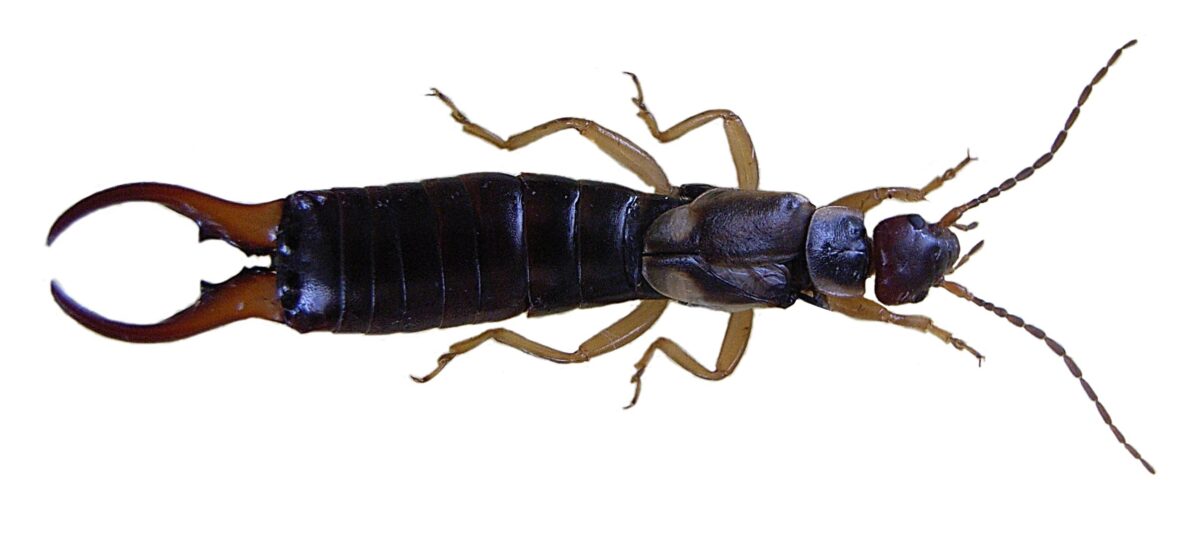When discussing bug with pincers, the term commonly refers to insects like earwigs. These creatures possess distinctive pincer-like structures at the end of their abdomens, which might evoke concern due to their appearance.
While earwigs are generally harmless to humans and even beneficial in some cases, controlling their populations can become necessary if they pose a nuisance indoors or in gardens. Additionally, other insects with pincer-like structures, such as certain beetles, might also be of concern depending on their behavior and impact.
Understanding Bugs with Pincers
Earwigs Identification and Behavior
- Physical Characteristics – Earwigs typically have elongated bodies, pincer-like cerci at the end of their abdomen, and membranous wings.
- Habitats – They favor moist environments and can be found in gardens, mulch, and dark, damp areas around buildings.
Other Pincer-Bearing Insects
- Beetles – Some beetles, like stag beetles, possess prominent pincers or mandibles, often used for defense or for handling food.
Effective Control Methods for Bug with Pincers
Outdoor Prevention
- Garden Maintenance – Clearing debris, reducing moisture, and minimizing organic matter in gardens diminishes favorable habitats for earwigs and certain beetles.
- Barriers and Traps – Creating physical barriers or using traps, like rolled-up newspapers or cardboard filled with straw, can help control populations.
Indoor Prevention
- Sealing Entry Points – Caulking gaps, repairing screens, and closing entry points around doors and windows prevent indoor infestations.
- Moisture Control – Addressing leaks and ensuring proper ventilation reduces the attractiveness of indoor space for bugs with pincers.
Natural Deterrents and Remedies
- Diatomaceous Earth This natural substance can be applied in areas frequented by these insects, as it dehydrates and kills them effectively.
- Essential Oils and Traps Certain essential oils, like citrus or peppermint, might repel these insects. Traps made of simple household materials can help reduce their numbers.
Specific Strategies for Different Pincer-Bearing Insects
Earwigs
- Garden Protection – Implementing less moisture-retentive mulch and encouraging natural predators like birds or certain insects can control earwig populations in gardens.
- Indoor Nuisance – Addressing moisture issues and sealing entry points prevents indoor infestations.
Beetles with Pincers
- Identification – Understanding specific beetle species is crucial, as some, like stag beetles, might require different control measures.
- Garden Maintenance – Managing habitats and organic matter in gardens helps control populations of beetles with pincers.
Challenges and Additional Considerations
Beneficial Aspects
Understanding the ecological roles of these insects is essential; they might prey on other pests or contribute to the ecosystem’s balance.
Selective Treatment
Not all insects with pincers might require intensive control measures unless they significantly impact human environments or plant life.
Environmental Impact
Emphasizing non-chemical control methods is eco-friendly and avoids potential harm to beneficial insects or pets.
Bug with Pincers FAQS
What are bugs with pincers, and how can I control them in my garden?
Bugs like earwigs and certain beetles possess pincers. Control methods include reducing moisture, clearing debris, and using traps or barriers in gardens.
Are bugs with pincers harmful, and how can I prevent them from entering my home?
Most bugs with pincers, like earwigs, are harmless. Prevent entry by sealing gaps, reducing moisture indoors, and using natural deterrents.
How do I identify and manage pincer-bearing insects in gardens without using chemicals?
Identifying species helps tailor control methods. Try natural remedies like diatomaceous earth, traps, and optimizing garden conditions.
Can bugs with pincers be beneficial, and what’s the best way to handle them without harming the environment?
Some bugs help control other pests. Adopt eco-friendly methods like traps, and barriers, and maintain garden hygiene.
What are the specific control measures for different bugs with pincers, like earwigs and beetles?
Targeted measures include reducing moisture, using essential oils, creating barriers, and encouraging natural predators, depending on the insect species.
Conclusion
Managing bugs with pincers involves a nuanced approach focused on reducing their populations rather than complete eradication. Understanding their behaviors, habitats, and specific control methods tailored to each species or scenario is crucial.
While these insects might seem daunting due to their appearance, most are harmless or even beneficial. Implementing preventive measures, natural deterrents, and targeted control methods can effectively manage their presence indoors and in gardens while maintaining ecological balance.


2 replies on “Bug With Pincers – Effective Strategies for Bug Control”
[…] Maintaining optimal temperature and moisture levels in the garden can deter ant and pest infestations. […]
[…] structure and affecting the growth of plants. Moreover, their presence can attract predators or other pests that further upset the garden’s […]